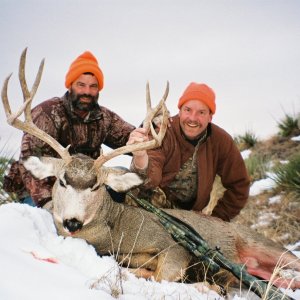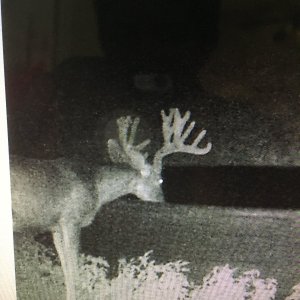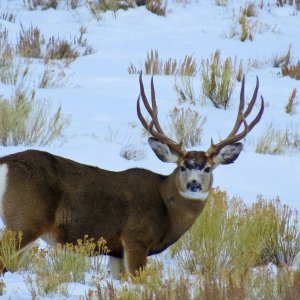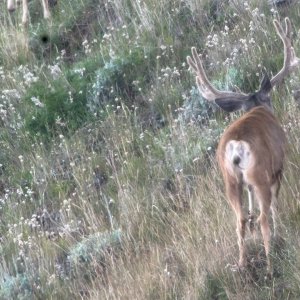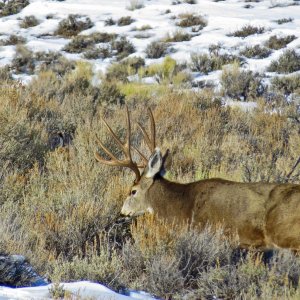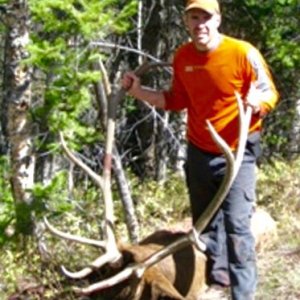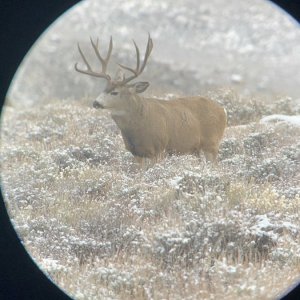BIGHORNtracks
Active Member
- Messages
- 104
Ever look through a couple spotting scopes and think "I cant tell the difference"?
Well, I am fortunate enough to own several spotting scopes. 4 actually.
My favorite is the Kowa prominar TSN 883. I love that thing.
Recently, I got a chance to put my X series Swarovski up against a Celestron Regal 100 ED.
I also tossed in a Swarovski STS 80 for fun. I figure that a $4,000 and a $3,000 scope up against a $700 scope would be like night and day in difference.
Well, it wasn't. I set them all up side by side with a subject at 1000 yards.
At 1000 yards, I could not read the words on the subject, but I could tell they were words with the X series, but could not read the words. With the STS and the Celestron, I could only make out the individual black blobs that made up the letters. I could not tell they were letters or read the words. Just black blobs.
Other than that, I really could not tell the difference between the $4,000 scope, and the $700 scope.
This got me thinking about all the posts you read from Vortex fan boys who love to compare the vortex to the Swarovski.
Well, being that I also own a Vortex razor 85, I decided to do a little experiment.
Let me say this is not an experiment to determine if the scopes are equal, or to justify any of your personal crap.
I do not care what scope you own, or use. It means nothing to me.
I own both optics, I am not invested emotionally in either.
Like I said earlier, the one that I believe is the best is the Kowa. Hands down, no questions asked, not even close.
So, Swarovski v/s vortex, who cares? not me.
I own both, my opinion is irrelevant.

I did this experiment simply to TRY AND UNDERSTAND THE ANSWER TO ONE QUESTION
When I look through two optics, under the same conditions, same parameters, WHY CANT I TELL A SIGNIFICANT DIFFERENCE?
Its a question, not a comparison.
If you want to use my findings to justify your opinion, knock yourself out. That is not what I am doing here.
For those of you interested in finding out what is happening, welcome! I want your opinions and feedback. Maybe I missed something. Maybe you have a test you would like to have me perform.
This is what I am interested in.
Now, to the test.
I wondered why I cant tell a significant difference.
The answer I gave myself was "its your eye!"
I know that when I walk out of a dark room, into a light space, my eye has the ability to compensate. The Pupil opens and closes to control the amount of light that gets in.
I did some research and found that the human eye can dilate to 7mm.
Interestingly enough, the exit pupil on most optics never reaches 7mm.
The Meopta meostar B1 8 X 56 binoculars do go to 7mm, but most spotting scopes hang out in the 1 - 4 mm range.
This means that the spotting scope is more limiting than your eye. Your eye can open up to gather more light than your scope will allow through to your eye.
But, what about when you don't need your eye to go to 7mm?
Lets say, you look through a Swarovski scope, and a vortex scope, side by side, under the same conditions, on the same power, same everything.
Question, DOES THE EYE DO SOMETHING DIFFERENT TO EQUALIZE THE VIEW?
Answer. I set this up. Two scopes side by side, same power, and photographed the eye from the front end of the scope.
Result.

It does. The pupil compensates for the reduced light from one scope to the next.
What does this mean? Well, it means that there is a difference between the scopes, but the reason its not obvious to you is because the eye is compensating. Trying to to find the ideal condition for itself.
The difference won't become obvious until low light conditions when the eye can no longer compensate. At this point, the scopes limitations will become obvious as a darker view occurs.
I found this interesting. I found it to be a significant part of the answer to my question.
So, if the eye is compensating, how can you get an equal comparison of two optics and know the difference? You don't know what your eye is doing. You cant feel it compensating.
So, to define the difference between two optics, you must eliminate the eye and its adjustments.
Well, digiscoping is the best way I found to remove the eye. Use a camera in place of the eye.
The problem? automatic camera adjustments.
Cameras can adjust aperture (camera pupil), shutter speed (how long the eye is open), and ISO ( sensitivity to light).
So the camera can do the same thing as the eye, based on its processor, trying to get the ideal photo according to its programming.
But, with the camera, you can control the eye. If you use full manual settings.
If you lock everything down so that no adjustment can be made by the camera, you can equalize the eye.
You can make the playing field perfectly level.
By doing this you can actually see the difference between one scope and another.
So, the new question becomes, WHAT WILL MY EYE SEE WHEN I MANUALLY FORCE IT TO REMAIN EQUAL LOOKING THROUGH TWO OPTICS?
Lets discuss parameters.
Focus can be an issue. one image out of focus, compared to one in focus may be of concern. So, what I did was shot 10 photos of each, taking the time to un focus, and re focus then take the next picture.
This way, a consistent result was able to be obtained.
The camera settings.
I used the same camera, with the same lens, and the same adapter to take the photos.
So, there is no variable in the camera equipment or the settings on the camera.
I set the settings once and used those settings to take all photos.
So the eye adjustment has been removed.
The only variable is the spotting scope itself.
Everything was done, side by side, at the same time, under the same conditions.
Same magnification settings on the scopes.
So, the only variable is the capability of each of the scopes.
The result.
Well, I did a long range test. 6 miles distance.
I set each scope to 60X magnification, went out to my back yard, and picked a spot on the mountain. A tree. I looked through each scope, trying to analyze the differences between each. Again, I was not able to see a significant difference with my eye.
Then I digiscoped it, with the camera.


There is was. The difference that I could not see with my eye.
The clear difference in light, that I cant perceive due to the adjustment of my pupil.
The answer to my question confirmed two different ways.
Crop pictures for reference.


Now, the lighting issue has been resolved, what about the clarity?
I can see a difference in clarity, but how much, and how much does that actually matter?
So, I set up a resolving bar chart. Set each scope to 30X. and using the camera, set to manual, on the exact same settings, I photographed the chart, 10 times with each, refocusing each time.


Yes, I know, vortex has a coating on their optics that gives off a magenta tint when viewing white objects. You cant see it when you look at most all outdoor scenes, but when you look at a bright white wall, the red tint really shows.
Get over it. the test is not about the color tint of the coatings. If you have a personal issue with it, thats your problem.
Crop images of the center set of bars.


With the chart, I can see there is a difference in clarity. The point where the bars begin to become one, rather than three with white in between is the scopes ability to resolve detail.
But you have to go down to the zoomed images to find the difference.
I decided that when looking at wildlife, this minor clarity and ability to separate fine detail is not immediately obvious to the eye.
It may help you see a cheater at 4 miles where the other may just look like a typical 4 point.
In my case, looking through my ATX scope v/s the Celestron regal, it was the ability to make out that there were letters, forming words, v/s just black blobs at 1000 yds.
But you really have to look at specific parts of the view to see that.
If you generally glance into the eyepiece, and look at the entire field of view, you may not notice the subtle differences, until you try to read those words.
I believe this has answered my question.
I hope you enjoyed it.
I hope you gained some understanding.
If you have an idea that would be an interesting test to try, please let me know. I would love to try and gain more understanding of the interaction between the eye and the scope, and how it effects our perception when looking trough a scope.
There will always be those who weigh cost against quality. There will always be those who are invested emotionally in the product they own. I get that. I don't want to upset those folks. I am not out to prove you wrong or right.
You may feel the difference is not worth the cost. Good for you. You might think its all that matters. Good for you.
I am only interested in what the difference is, and why its there.
Whether paying for it is worth while is irrelevant to me. I own both. If I want the highest in quality, I have it. if I want to settle, I can do that as well.
But in al honesty, when I looked through that $700 Celestron Regal 100 ED, I realized that my curiosity had been lit up like a bonfire.
Either that Celestron was the best scope for the money, on the market, or there was something else at play here.
When viewed with my eye, the Celestron was equal to the Swarovski STS 80. Nearly as good as the Swarovski ATX. Much better than the vortex razor 85.
So, I had to find out why. It was simple curiouslity. That curiosity still exists.
I just don't have any more ideas for tests to run.
Got any?

Well, I am fortunate enough to own several spotting scopes. 4 actually.
My favorite is the Kowa prominar TSN 883. I love that thing.
Recently, I got a chance to put my X series Swarovski up against a Celestron Regal 100 ED.
I also tossed in a Swarovski STS 80 for fun. I figure that a $4,000 and a $3,000 scope up against a $700 scope would be like night and day in difference.
Well, it wasn't. I set them all up side by side with a subject at 1000 yards.
At 1000 yards, I could not read the words on the subject, but I could tell they were words with the X series, but could not read the words. With the STS and the Celestron, I could only make out the individual black blobs that made up the letters. I could not tell they were letters or read the words. Just black blobs.
Other than that, I really could not tell the difference between the $4,000 scope, and the $700 scope.
This got me thinking about all the posts you read from Vortex fan boys who love to compare the vortex to the Swarovski.
Well, being that I also own a Vortex razor 85, I decided to do a little experiment.
Let me say this is not an experiment to determine if the scopes are equal, or to justify any of your personal crap.
I do not care what scope you own, or use. It means nothing to me.
I own both optics, I am not invested emotionally in either.
Like I said earlier, the one that I believe is the best is the Kowa. Hands down, no questions asked, not even close.
So, Swarovski v/s vortex, who cares? not me.
I own both, my opinion is irrelevant.

I did this experiment simply to TRY AND UNDERSTAND THE ANSWER TO ONE QUESTION
When I look through two optics, under the same conditions, same parameters, WHY CANT I TELL A SIGNIFICANT DIFFERENCE?
Its a question, not a comparison.
If you want to use my findings to justify your opinion, knock yourself out. That is not what I am doing here.
For those of you interested in finding out what is happening, welcome! I want your opinions and feedback. Maybe I missed something. Maybe you have a test you would like to have me perform.
This is what I am interested in.
Now, to the test.
I wondered why I cant tell a significant difference.
The answer I gave myself was "its your eye!"
I know that when I walk out of a dark room, into a light space, my eye has the ability to compensate. The Pupil opens and closes to control the amount of light that gets in.
I did some research and found that the human eye can dilate to 7mm.
Interestingly enough, the exit pupil on most optics never reaches 7mm.
The Meopta meostar B1 8 X 56 binoculars do go to 7mm, but most spotting scopes hang out in the 1 - 4 mm range.
This means that the spotting scope is more limiting than your eye. Your eye can open up to gather more light than your scope will allow through to your eye.
But, what about when you don't need your eye to go to 7mm?
Lets say, you look through a Swarovski scope, and a vortex scope, side by side, under the same conditions, on the same power, same everything.
Question, DOES THE EYE DO SOMETHING DIFFERENT TO EQUALIZE THE VIEW?
Answer. I set this up. Two scopes side by side, same power, and photographed the eye from the front end of the scope.
Result.

It does. The pupil compensates for the reduced light from one scope to the next.
What does this mean? Well, it means that there is a difference between the scopes, but the reason its not obvious to you is because the eye is compensating. Trying to to find the ideal condition for itself.
The difference won't become obvious until low light conditions when the eye can no longer compensate. At this point, the scopes limitations will become obvious as a darker view occurs.
I found this interesting. I found it to be a significant part of the answer to my question.
So, if the eye is compensating, how can you get an equal comparison of two optics and know the difference? You don't know what your eye is doing. You cant feel it compensating.
So, to define the difference between two optics, you must eliminate the eye and its adjustments.
Well, digiscoping is the best way I found to remove the eye. Use a camera in place of the eye.
The problem? automatic camera adjustments.
Cameras can adjust aperture (camera pupil), shutter speed (how long the eye is open), and ISO ( sensitivity to light).
So the camera can do the same thing as the eye, based on its processor, trying to get the ideal photo according to its programming.
But, with the camera, you can control the eye. If you use full manual settings.
If you lock everything down so that no adjustment can be made by the camera, you can equalize the eye.
You can make the playing field perfectly level.
By doing this you can actually see the difference between one scope and another.
So, the new question becomes, WHAT WILL MY EYE SEE WHEN I MANUALLY FORCE IT TO REMAIN EQUAL LOOKING THROUGH TWO OPTICS?
Lets discuss parameters.
Focus can be an issue. one image out of focus, compared to one in focus may be of concern. So, what I did was shot 10 photos of each, taking the time to un focus, and re focus then take the next picture.
This way, a consistent result was able to be obtained.
The camera settings.
I used the same camera, with the same lens, and the same adapter to take the photos.
So, there is no variable in the camera equipment or the settings on the camera.
I set the settings once and used those settings to take all photos.
So the eye adjustment has been removed.
The only variable is the spotting scope itself.
Everything was done, side by side, at the same time, under the same conditions.
Same magnification settings on the scopes.
So, the only variable is the capability of each of the scopes.
The result.
Well, I did a long range test. 6 miles distance.
I set each scope to 60X magnification, went out to my back yard, and picked a spot on the mountain. A tree. I looked through each scope, trying to analyze the differences between each. Again, I was not able to see a significant difference with my eye.
Then I digiscoped it, with the camera.


There is was. The difference that I could not see with my eye.
The clear difference in light, that I cant perceive due to the adjustment of my pupil.
The answer to my question confirmed two different ways.
Crop pictures for reference.


Now, the lighting issue has been resolved, what about the clarity?
I can see a difference in clarity, but how much, and how much does that actually matter?
So, I set up a resolving bar chart. Set each scope to 30X. and using the camera, set to manual, on the exact same settings, I photographed the chart, 10 times with each, refocusing each time.


Yes, I know, vortex has a coating on their optics that gives off a magenta tint when viewing white objects. You cant see it when you look at most all outdoor scenes, but when you look at a bright white wall, the red tint really shows.
Get over it. the test is not about the color tint of the coatings. If you have a personal issue with it, thats your problem.
Crop images of the center set of bars.


With the chart, I can see there is a difference in clarity. The point where the bars begin to become one, rather than three with white in between is the scopes ability to resolve detail.
But you have to go down to the zoomed images to find the difference.
I decided that when looking at wildlife, this minor clarity and ability to separate fine detail is not immediately obvious to the eye.
It may help you see a cheater at 4 miles where the other may just look like a typical 4 point.
In my case, looking through my ATX scope v/s the Celestron regal, it was the ability to make out that there were letters, forming words, v/s just black blobs at 1000 yds.
But you really have to look at specific parts of the view to see that.
If you generally glance into the eyepiece, and look at the entire field of view, you may not notice the subtle differences, until you try to read those words.
I believe this has answered my question.
I hope you enjoyed it.
I hope you gained some understanding.
If you have an idea that would be an interesting test to try, please let me know. I would love to try and gain more understanding of the interaction between the eye and the scope, and how it effects our perception when looking trough a scope.
There will always be those who weigh cost against quality. There will always be those who are invested emotionally in the product they own. I get that. I don't want to upset those folks. I am not out to prove you wrong or right.
You may feel the difference is not worth the cost. Good for you. You might think its all that matters. Good for you.
I am only interested in what the difference is, and why its there.
Whether paying for it is worth while is irrelevant to me. I own both. If I want the highest in quality, I have it. if I want to settle, I can do that as well.
But in al honesty, when I looked through that $700 Celestron Regal 100 ED, I realized that my curiosity had been lit up like a bonfire.
Either that Celestron was the best scope for the money, on the market, or there was something else at play here.
When viewed with my eye, the Celestron was equal to the Swarovski STS 80. Nearly as good as the Swarovski ATX. Much better than the vortex razor 85.
So, I had to find out why. It was simple curiouslity. That curiosity still exists.
I just don't have any more ideas for tests to run.
Got any?


